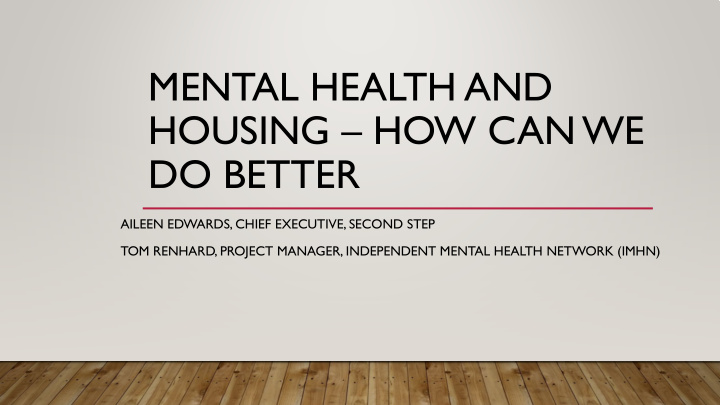



MENTAL HEALTH AND HOUSING – HOW CAN WE DO BETTER AILEEN EDWARDS, CHIEF EXECUTIVE, SECOND STEP TOM RENHARD, PROJECT MANAGER, INDEPENDENT MENTAL HEALTH NETWORK (IMHN)
BACKGROUND • 45% of people accessing support from community mental health teams are in insecure accommodation. • Homelessness pathway – 78% of people in the pathway have mental health needs. • 60% of people highlighted housing pressures cause stress and anxiety. • Social determinants of health a factor in wellbeing (e.g. housing / employment / financial health / roll out of universal credit). • Seeking to bring the voices of those with lived experience together with professionals and key decision makers.
OPPORTUNITIES TO DO THINGS DIFFERENTLY IN BRISTOL • One City Approach • Thrive Bristol (one of eleven workstreams will focus on housing) • The Bristol North Somerset and South Gloucestershire Sustainability Partnership (BNSSG STP – Healthier T ogether) – opportunity to link in with developing mental health strategy • Homelessness, Housing and Rough Sleeping Strategy (City Council) • Be a city delivering best practice and innovation • Better integration between housing and health at a strategic level • Better Lives Strategy (Social Care) • Mental health is everybody’s business
WHAT WE DID • Mental Health Conversations event – End of November 2017 • Small working group convened and meeting between February and May 2017 • Report developed and discussed with key stakeholders July – November 2017
WHAT THE REPORT IS ABOUT AND WHO IT IS FOR • It has been produced by the Mental Heath and Housing short-life working group • It sets out how to address identified gaps in the way services work in Bristol for people experiencing the connected issues of mental ill-health and housing/homelessness. • The work of the group focused on adults, but we know that homelessness also has a huge impact on the lives of children and young people. • The report looks at on what can be done differently in our City to achieve change, and reflects a shared commitment by all those involved, to be part of the change.
THINKING ABOUT COMMONALITY AND LEVEL OF NEED A. People experiencing B. People experiencing complex/serious complex/serious mental health mental health problems such as problems such as psychosis, who are psychosis, who are housed; but where homeless including those sleeping they may be poorly housed and there is rough. a risk of this breaking down and them becoming homeless. Need C. People experiencing common D. People experiencing common mental mental health problems such as health problems such as depression and depression and anxiety, who are anxiety who are housed; but where homeless including those sleeping they may be poorly housed and there is rough. a risk of this breaking down and them becoming homeless. Housing Security
KEY THEMES (1) • Levels of poverty, challenges with Universal Credit, and rising debt are significant factors; • The need for more integrated services into the homelessness sector to reach people who don’t access services; • The importance of skilling up the mental health and housing sectors to intervene early and not to fall back on punitive actions; • A lack of understanding of the connections between domestic violence, mental health and housing; • A lack of understanding of cultural factors, how people with diverse backgrounds may present differently, and how this contributes to increasing stigma and widening inequalities.
KEY THEMES (2) • Impact of social isolation can be significant – there is a need for this to be addressed through the One City Approach • There is a lack of range and type of housing for people with mental health needs, including specific issues for young people; • People with lived experience and co-production should be at the heart of service delivery and service commissioning, so service design is client-centred; • Prevention - intervening early to avoid mental health and housing problems escalating and becoming crises; • PIE across the board – PIE principles to inform the design of housing schemes and the physical environment, the way we engage and work with people, and the creation of safe spaces city- wide;
KEY RECOMMENDATIONS (1) • Leadership by the City, to ensure a coordinated, joined up, city-wide approach, and action, with the involvement of people with lived experience; • More dedicated provision for people with significant mental health needs in self- contained and supported housing projects, including provision for young people; • Expand Housing First, with a mental health specific element, as part of the housing solution; • Protect Mental Health floating support services to reduce risk of homelessness; • More sustainable, integrated social care provision;
KEY RECOMMENDATIONS (2) • Strengthen early intervention work with children and young people, identifying risk factors, and taking an integrated approach to preventing homelessness and mental health problems; • Strengthen information/support to landlords and tenants for where to go when a tenant is in mental health crisis; • Expand housing options when mental health is at risk and offer earlier preventative support, to avoid mental health deterioration; • Make design features which create a healthy, wellbeing environment a standard requirement within all housing developments.
THANKS FOR LISTENING AND QUESTIONS?
Recommend
More recommend